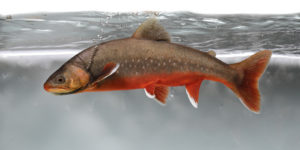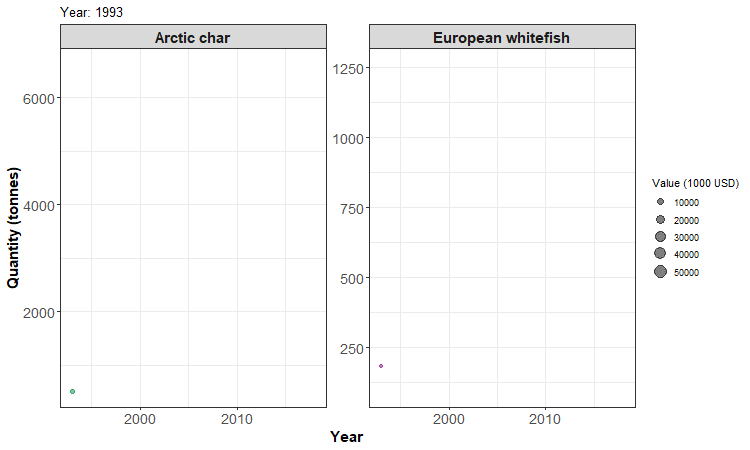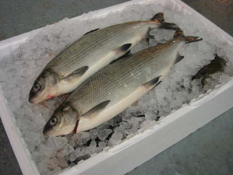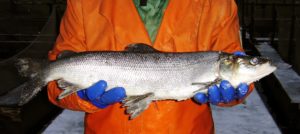The ARCTAQUA project will generate knowledge to make the farming of whitefishes (nelma and European whitefish), spotted wolffish and Arctic char commercially and economically viable in the Arctic region.
European whitefish (Coregonus lavaretus)
European whitefish is an anadromous fish, populations of which are found in two Finnish rivers, Tornionjoki and Kiiminkijoki, and these water bodies flow into the northern Gulf of Bothnia. European whitefish that are found in northern Finland are mostly of length 80 – 100 mm. River-spawning densely rakered fish can also be found in the Koitajoki river in Eastern Finland. The fish is acid-tolerant and spawns in acid-rich rivers. Natural populations of this benthophage mature when they achieve a weight of 800 g. The fecundity range of this whitefish is 30 to 70 thousand eggs. This whitefish is the second most-valued farmed species in Finland after rainbow trout, and the two threats to the indigenous whitefish population in Finland are overexploitation and hybridization. This whitefish has a low content of cholesterol but is rich in n-3 polyunsaturated fatty acids.
In the project ARCTAQUA, we will develop state-of-the-art practices for broodstock management. Through cross-country co-operation, we will assess the genetic diversity of Coregonus species for stock identification.
Nelma (Stenodus leucichthys nelma)
European nelma is a sizeable freshwater predator, reaching up to 40 kg or more. Nelma inhabits different rivers flowing into the Arctic Ocean. Distribution areas of the species in the European part of Russia are the rivers of the Kola Peninsula. The main populations of nelma inhabit the basins of the Pechora and Northern Dvina Rivers. Nelma feeds in the downstream and estuaries where salinities can go up to 20-30 ‰. The fish’s spawning locations are rivers headwaters and lakes. There are also some lake strains. Nelma matures at 10-15 years and presents a relatively high fecundity 80-250 thousand eggs. Eggs are relatively small compared with other salmonids – 2-2.6 mm. Their numbers in nature have been sharply reduced and the European strains of nelma are in the Russian Red Book and labelled as endangered species. Because of its high nutritional value and market price, nelma is considered as a promising aquaculture species. Its high-calorie white flesh holding 1900 kcal/kg is a source of amino acids, trace elements and vitamins. Nelma from the Kubensky lake is the most appropriate strain for cage farming; it has a high growth rate (mature fish increases more than 1 kg per year), early maturation – 4 + -5 +, high fecundity – about 130 thousand eggs, and they easily adapt to artificial feeds.
Nelma investigations in the ARCTAQUA project are aimed to resolve actual problems of its commercial cultivation and broodstocks management:
- the development of diets for spawners to improve the quality of eggs and offspring
- improving the nelma cultivation technology
- expanding knowledge for disease prevention of whitefishes in aquaculture
- creating histological atlas of embryonic development.
Spotted wolffish (Anarhichas minor)

Spotted wolffish are bottom dwellers found at depths of 100-400 m. The distribution areas are in the Arctic region, mainly in the North Atlantic Ocean and the Barents Sea. The fish can attain a length of 190 cm, and the corresponding weight is 25 kg. The main threat to the fish is commercial fishing, but climate change has also affected their distribution. Spotted wolffish has been considered for a long time as a potential species for cold-water marine aquaculture. The fillet of the fish has an intricate firm texture, which makes it a culinary delight in the Scandinavia. It is now commercially produced on a small scale with a plan for expansion, by tackling the bottlenecks related to its production.
In the project ARCTAQUA, we will be optimizing the start-feeding conditions, developing grow-out diets and developing protocols for preventive health care and disease treatment.
Arctic char (Salvelinus alpinus)

Arctic char is an ecological generalist, and through its Holarctic distribution in both marine and freshwater environments, it contributes to the sustainability of the Arctic ecosystems. Arctic char spawns in lakes, streams and rivers. Predatory Arctic char with vibrant colours grow to over 50 cm (2 kg), and the dwarf type grows to around 20 cm (100 g). The female fish lays 2,500 to 8,500 eggs of 4 to 4.5 mm size. Arctic char is a species of paramount importance for the aquaculture industry particularly in the Arctic region with significant potential for further expansion. The main hurdle associated with the expansion of Arctic char farming is its low fertility compared to other farmed salmonids.
In ARCTAQUA we will apply state-of-the-art genomic technologies for understanding the genetic components that influence the fertility of Arctic char. In addition, we will establish better fertilization techniques and develop technology for its production in recirculation aquaculture systems (RAS).
Aquaculture production and value of 2 species that are studied in ARCTAQUA are shown in the below image (based on the data from http://www.fao.org/fishery/statistics/global-production/query/en).



